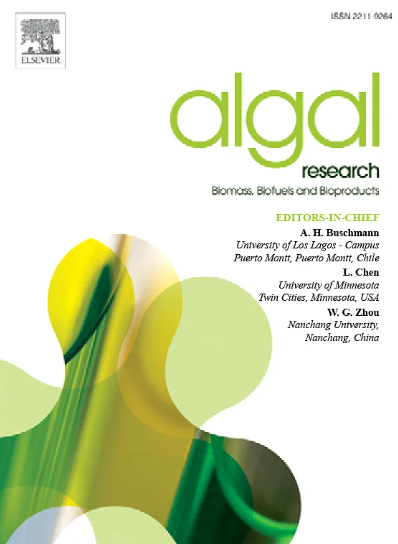Lighting strategy drives removal of ammonia nitrogen and phosphate in microalgae-bacteria consortia under tetracycline hydrochloride exposure
IF 4.6
2区 生物学
Q1 BIOTECHNOLOGY & APPLIED MICROBIOLOGY
Algal Research-Biomass Biofuels and Bioproducts
Pub Date : 2025-03-11
DOI:10.1016/j.algal.2025.103989
引用次数: 0
Abstract
Microalgae and bacteria interactions play an important role in nutrient absorption and utilization. Lighting strategies are extremely crucial factors for the interaction of microalgae-bacteria consortia for the deep treatment of swine wastewater containing antibiotics. In this study, a co-culture system of Chlorella sorokiniana and Paracoccus pantotrophus was constructed to explore the effects of lighting strategy and tetracycline hydrochloride (TCH) on ammonia nitrogen (NH4+-N) and phosphates removal. The results showed that the co-culture system overtly increased the removal of NH4+-N and phosphate, with the maximum removal efficiencies of 85.75 % and 75.5 %, respectively. The photosynthetic activity (Fv/fm) of C. sorokiniana in the co-culture system was measured by a handheld algal fluorescence meter, and the value increased from 0.47 to 0.61 in comparison to the monoculture. Under complete darkness, the NH4+-N removal efficiency was only 67.46 %, while the light/dark ratio increase from 12:12 to 24:0 promoted the NH4+-N removal efficiency to a maximum of 87.66 %. Meanwhile, the activities of glutamate synthase (GS) and glutamine synthetase (GOGAT) assayed according to the enzyme activity detection kit were the highest with 8696 and 411 U/g prot, respectively. When TCH concentration increased from 0.5 to 2.0 mg/L, the NH4+-N removal efficiency decreased from 84.07 % to 71.48 %, which might be due to the toxic effect of TCH on bacteria, leading to a decrease in the activities of GOGAT and GS in the co-culture system. In addition, the co-culture system also had a well removal on TCH, with the maximum removal efficiency reaching 93.33 %. The co-culture system performed well in the removal of pollutants (NH4+-N, PO4+-P and TCH), which provided a feasible and sustainable technology for the advanced treatment of swine wastewater.
光照策略驱动盐酸四环素暴露下微藻-菌群中氨氮和磷酸盐的去除
微藻与细菌的相互作用在养分的吸收和利用中起着重要作用。光照策略是影响微藻-菌群深度处理含抗生素猪废水的关键因素。本研究构建了小球藻与泛养副球菌的共培养体系,探讨光照策略和盐酸四环素(TCH)对氨氮(NH4+-N)和磷酸盐去除的影响。结果表明,共培养体系显著提高了氨氮和磷酸盐的去除率,最高去除率分别为85.75%和75.5%。用手持式藻类荧光仪测定了共培养体系中sorokiniana的光合活性(Fv/fm),与单培养相比,Fv/fm由0.47提高到0.61。在完全黑暗条件下,NH4+-N去除率仅为67.46%,而光暗比从12:12增加到24:0时,NH4+-N去除率最高可达87.66%。同时,谷氨酸合成酶(GS)和谷氨酰胺合成酶(GOGAT)活性最高,分别为8696和411 U/g prot。当TCH浓度从0.5 mg/L增加到2.0 mg/L时,NH4+-N去除率从84.07%下降到71.48%,这可能是由于TCH对细菌的毒性作用,导致共培养体系中GOGAT和GS活性降低。此外,共培养体系对TCH也有较好的去除效果,最高去除率达93.33%。该共培养系统对污染物(NH4+-N、PO4+-P和TCH)的去除效果良好,为养猪废水深度处理提供了一种可行且可持续的技术。
本文章由计算机程序翻译,如有差异,请以英文原文为准。
求助全文
约1分钟内获得全文
求助全文
来源期刊

Algal Research-Biomass Biofuels and Bioproducts
BIOTECHNOLOGY & APPLIED MICROBIOLOGY-
CiteScore
9.40
自引率
7.80%
发文量
332
期刊介绍:
Algal Research is an international phycology journal covering all areas of emerging technologies in algae biology, biomass production, cultivation, harvesting, extraction, bioproducts, biorefinery, engineering, and econometrics. Algae is defined to include cyanobacteria, microalgae, and protists and symbionts of interest in biotechnology. The journal publishes original research and reviews for the following scope: algal biology, including but not exclusive to: phylogeny, biodiversity, molecular traits, metabolic regulation, and genetic engineering, algal cultivation, e.g. phototrophic systems, heterotrophic systems, and mixotrophic systems, algal harvesting and extraction systems, biotechnology to convert algal biomass and components into biofuels and bioproducts, e.g., nutraceuticals, pharmaceuticals, animal feed, plastics, etc. algal products and their economic assessment
 求助内容:
求助内容: 应助结果提醒方式:
应助结果提醒方式:


